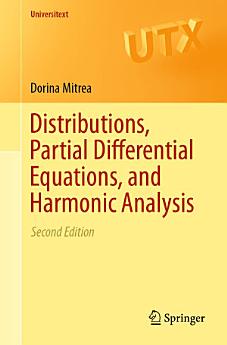Distributions, Partial Differential Equations, and Harmonic Analysis: Edition 2
ធ្នូ 2018 · Springer
សៀវភៅអេឡិចត្រូនិច
600
ទំព័រ
reportការវាយតម្លៃ និងមតិវាយតម្លៃមិនត្រូវបានផ្ទៀងផ្ទាត់ទេ ស្វែងយល់បន្ថែម
អំពីសៀវភៅអេឡិចត្រូនិកនេះ
The aim of this book is to offer, in a concise, rigorous, and largely self-contained manner, a rapid introduction to the theory of distributions and its applications to partial differential equations and harmonic analysis. The book is written in a format suitable for a graduate course spanning either over one-semester, when the focus is primarily on the foundational aspects, or over a two-semester period that allows for the proper amount of time to cover all intended applications as well. It presents a balanced treatment of the topics involved, and contains a large number of exercises (upwards of two hundred, more than half of which are accompanied by solutions), which have been carefully chosen to amplify the effect, and substantiate the power and scope, of the theory of distributions. Graduate students, professional mathematicians, and scientifically trained people with a wide spectrum of mathematical interests will find this book to be a useful resource and complete self-study guide. Throughout, a special effort has been made to develop the theory of distributions not as an abstract edifice but rather give the reader a chance to see the rationale behind various seemingly technical definitions, as well as the opportunity to apply the newly developed tools (in the natural build-up of the theory) to concrete problems in partial differential equations and harmonic analysis, at the earliest opportunity.
The main additions to the current, second edition, pertain to fundamental solutions (through the inclusion of the Helmholtz operator, the perturbed Dirac operator, and their iterations) and the theory of Sobolev spaces (built systematically from the ground up, exploiting natural connections with the Fourier Analysis developed earlier in the monograph).
The main additions to the current, second edition, pertain to fundamental solutions (through the inclusion of the Helmholtz operator, the perturbed Dirac operator, and their iterations) and the theory of Sobolev spaces (built systematically from the ground up, exploiting natural connections with the Fourier Analysis developed earlier in the monograph).
អំពីអ្នកនិពន្ធ
Dorina Mitrea is a Professor at University of Missouri in the Mathematics Department.
វាយតម្លៃសៀវភៅអេឡិចត្រូនិកនេះ
ប្រាប់យើងអំពីការយល់ឃើញរបស់អ្នក។
អានព័ត៌មាន
ទូរសព្ទឆ្លាតវៃ និងថេប្លេត
ដំឡើងកម្មវិធី Google Play Books សម្រាប់ Android និង iPad/iPhone ។ វាធ្វើសមកាលកម្មដោយស្វ័យប្រវត្តិជាមួយគណនីរបស់អ្នក និងអនុញ្ញាតឱ្យអ្នកអានពេលមានអ៊ីនធឺណិត ឬគ្មានអ៊ីនធឺណិតនៅគ្រប់ទីកន្លែង។
កុំព្យូទ័រយួរដៃ និងកុំព្យូទ័រ
អ្នកអាចស្ដាប់សៀវភៅជាសំឡេងដែលបានទិញនៅក្នុង Google Play ដោយប្រើកម្មវិធីរុករកតាមអ៊ីនធឺណិតក្នុងកុំព្យូទ័ររបស់អ្នក។
eReaders និងឧបករណ៍ផ្សេងទៀត
ដើម្បីអាននៅលើឧបករណ៍ e-ink ដូចជាឧបករណ៍អានសៀវភៅអេឡិចត្រូនិក Kobo អ្នកនឹងត្រូវទាញយកឯកសារ ហើយផ្ទេរវាទៅឧបករណ៍របស់អ្នក។ សូមអនុវត្តតាមការណែនាំលម្អិតរបស់មជ្ឈមណ្ឌលជំនួយ ដើម្បីផ្ទេរឯកសារទៅឧបករណ៍អានសៀវភៅអេឡិចត្រូនិកដែលស្គាល់។






